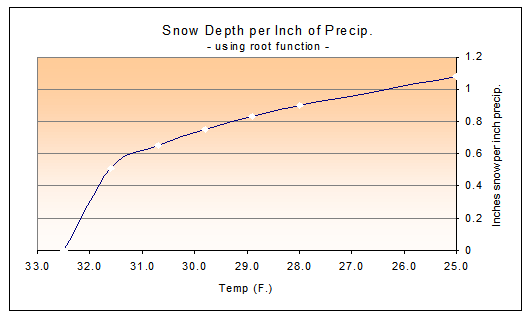|
The Problem of Snow Density
In order to convert precip to new snow depth, the simplest solution if to use the ’ten to one’ rule; ten inches of snow per tenth inch of precip, regardless of temperature. Not very realistic.
Another solution is to use the National Weather Service New Snowfall to Estimated Meltwater Conversion table. For every tenth inch precip, the table estimates the new snowfall as follows: 34 to 28 deg. – 1.0 inches 27 to 20 deg. – 1.5 inches 19 to 15 deg. – 2.0 inches 14 to 10 deg. – 3.0 inches Etc.
This may be a better solution, but it requires a lot of work to implement in the model, and it’s still incremental. Also, since temps on the valley floor are often near freezing, estimating an inch of new snow per inch at a temp of 34 degrees will lead to significant errors.
The model currently uses a power function times a multiplier with easily adjustable constants that have global effect. The constants are tweaked based on field info. Here is an example based on the settings from January 2007. I’ve since modified them slightly. |

|
Based on the NWS table, the function graphed above may be underestimating snow depth at lower temperatures, but that is not supported by field data.
|